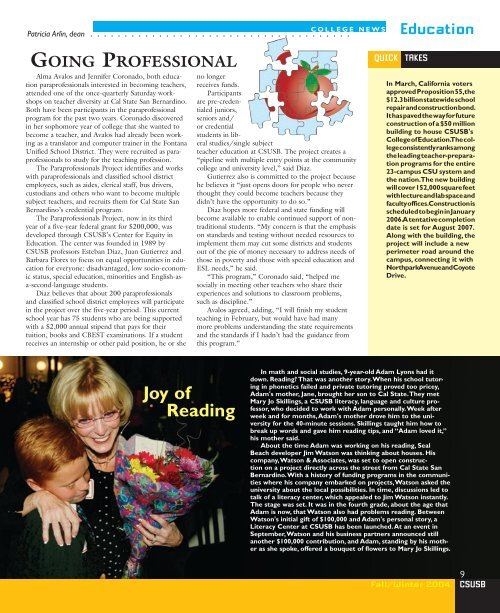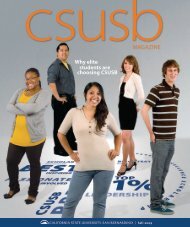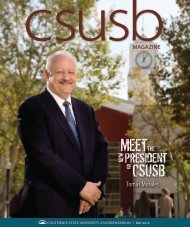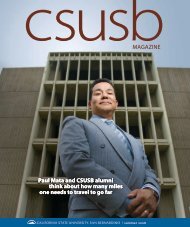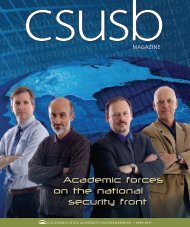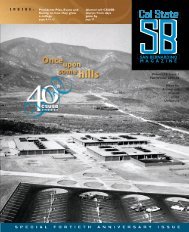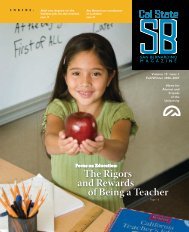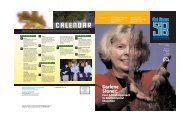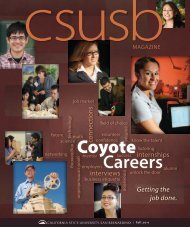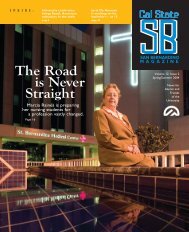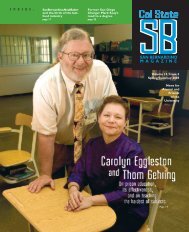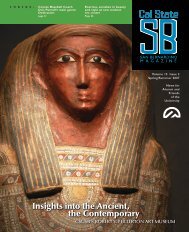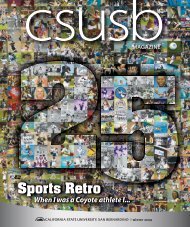Business & Public Administration C O L L E G E N E W S. . . . . . . . . . . . . Karen Dill Bowerman, deanQUICK TAKESIf Klaus Brasch is a biologyprofessor at Cal <strong>State</strong><strong>San</strong> Bernardino, why didhe receive an award fromthe U.S. Small BusinessAdministration? It’s becauseBrasch champions innovation.The organization hashonored him with its 20<strong>04</strong>Research Advocate of theYear award. The executivedirector for research,development and technologytransfer at <strong>CSUSB</strong>since 1998, Brasch has promotednot only researchand innovation on campus,but also in the community.His expert advice, particularlyto companies ownedby minorities and women,has supported the productsof many of these small businesses.Brasch was one of10 awardees honored by the<strong>San</strong>ta Ana office of the SmallBusiness Administration.■In a class offered for thefirst time this past spring,students are learning the insand outs of sports marketing,including merchandising,promotions and ticketing.They’ve worked with suchevents and organizations asthe PGA Charity Classic golftourney, the Inland Empire66ers and Motocross desertracing.GOODVIBRATIONSThe aura of Karen Dill Bowermanwas shining bright in early August.Just four days on the job, the newdean for the business college stoleaway from her office to mingleamong university advancement divisionstaff and managers as they heldKaren Dill Bowermantheir annual work retreat. It was during lunch thatguest speaker Katherine Wysocki, a psychologist,author of the book “Your Personal Coach” and onewho had a talent for reading auras, mentioned asshe spoke that Bowerman’s energy vibrations werein particularly good supply — confirmation that theCollege of Business and Public Administration wasgoing to be in good hands.Those who’d met Bowerman at the retreat andthose who’d interviewed her for the job already hadan inkling. After accepting the post and well beforearriving at Cal <strong>State</strong>, the former associate dean ofFresno <strong>State</strong> <strong>University</strong>’s Craig School of Businesswas already plotting a course for her new academiccharge. She began by tackling <strong>CSUSB</strong>’s lengthy andrecently completed Western Association of Schoolsand Colleges report as well as reading an Associationto Advance Collegiate Schools of Business assessmentof the university’s business college. The AACSB hadrecently renewed Cal <strong>State</strong>’s accreditation status. Thereports, she says, showed that “the faculty and studentsare already deeply involved in the community,and there are many more opportunities for the collegeto foster business growth in the Inland Empire.”No less bright than Bowerman’s personal qualitiesare her professional credits. At Fresno she hadbeen a professor of management and human resourcesmanagement since 1979.She also has been a memberof the <strong>California</strong> Awardsfor Performance ExcellenceBoard of Governors, haspublished several instructors’guidebooks and video casesfor human resource managementtextbooks, and hasoffered expert testimony inthe areas of human resourcesand management. Bowerman,who took over from NortonMarks, the <strong>CSUSB</strong> professorof marketing who had beenserving as the college’s interimdean, earned her bachelor’s degree in political science/speechin 1969 from Wichita <strong>State</strong> <strong>University</strong>.Her master’s degree in interpersonal relations camefrom Kansas <strong>University</strong> in 1970 and her doctoratecame from Texas A&M <strong>University</strong> in educationaladministration in 1979.“Understanding others’ dreams for our collegeis critical,” says Bowerman. “Our visions and goalsoften gel when we write them down and invite feedback.”So key on her agenda for now is to listen.She’s meeting with students, professors, alumni,administrators and, naturally, she adds, people in thecommunity.Essentially, Lou Fernandez, vice president andprovost for <strong>CSUSB</strong>, had spied in Bowerman thesame vim as had the lunchtime speaker at the Augustadvancement retreat. “Dr. Bowerman brings with heran enthusiasm, vitality and vision that I feel will bea tremendous asset to the College of Business andPublic Administration,” he had said when the universityhired her.“I’m a positive person and like to be surroundedby others who are positive,” Bowerman says. “Maybethat approach to life leads to energy and enthusiasm.We all have days that are more rough than others,but when we realize what a blessing life is, beingpositive comes naturally.”The rash of revelations onfraudulent or questionablebookkeeping methodsby top management inmajor U.S. companiesis the backdrop fora new course beingoffered at Cal <strong>State</strong><strong>San</strong> Bernardino.The ethics inaccounting class examinesthe effects on investors, businessesand government when companies deliberatelymislead by manipulating their financialstatements, how companies “cook their books”ENRON: A FINE EXAMPLE OF POOR JUDGMENTand the role of corporate management,auditors and financial analysts in hiding thetruth, said <strong>CSUSB</strong> lecturer Steven Mintz,who developed the course for accountingand business students. The course’s goal isto instill a strong sense of ethics in <strong>CSUSB</strong>business students.“Our hope is that they will resist pressuresimposed by some in top management to be a‘team player’ and possibly become part of thekinds of scams and cover-ups that have broughtdown all too many U.S. companies,” Mintz said.The class was developed in response to thoserevelations and the financial repercussions – insome cases ruin – seen by shareholders and companyemployees. Many have watched their companystock holdings, investments and retirementfunds drop to next to nothing.The “financial shenanigans” by companiessuch as Global Crossing, Enron, Adelphia andWorldCom have triggered stock price declinesof literally 99 percent in all of these cases, Mintzsaid. The revelations of those business dealingsled to Fed Chairman Alan Greenspan warningCongress that the corporate financial scandalsthreaten the nation’s slowly mending economy.8<strong>CSUSB</strong>Fall/Winter 20<strong>04</strong>
C O L L E G E N E W SPatricia Arlin, dean . . . . . . . . . . . . . . . . . . . . . . . . . . . . . . . . . . . . . .EducationGOING PROFESSIONALAlma Avalos and Jennifer Coronado, both educationparaprofessionals interested in becoming teachers,attended one of the once-quarterly Saturday workshopson teacher diversity at Cal <strong>State</strong> <strong>San</strong> Bernardino.Both have been participants in the paraprofessionalprogram for the past two years. Coronado discoveredin her sophomore year of college that she wanted tobecome a teacher, and Avalos had already been workingas a translator and computer trainer in the FontanaUnified School District. They were recruited as paraprofessionalsto study for the teaching profession.The Paraprofessionals Project identifies and workswith paraprofessionals and classified school districtemployees, such as aides, clerical staff, bus drivers,custodians and others who want to become multiplesubject teachers, and recruits them for Cal <strong>State</strong> <strong>San</strong>Bernardino’s credential program.The Paraprofessionals Project, now in its thirdyear of a five-year federal grant for $200,000, wasdeveloped through <strong>CSUSB</strong>’s Center for Equity inEducation. The center was founded in 1989 by<strong>CSUSB</strong> professors Esteban Diaz, Juan Gutierrez andBarbara Flores to focus on equal opportunities in educationfor everyone: disadvantaged, low socio-economicstatus, special education, minorities and English-asa-second-languagestudents.Diaz believes that about 200 paraprofessionalsand classified school district employees will participatein the project over the five-year period. This currentschool year has 75 students who are being supportedwith a $2,000 annual stipend that pays for theirtuition, books and CBEST examinations. If a studentreceives an internship or other paid position, he or sheno longerreceives funds.Participantsare pre-credentialedjuniors,seniors and/or credentialstudents in liberalstudies/single subjectteacher education at <strong>CSUSB</strong>. The project creates a“pipeline with multiple entry points at the communitycollege and university level,” said Diaz.Gutierrez also is committed to the project becausehe believes it “just opens doors for people who neverthought they could become teachers because theydidn’t have the opportunity to do so.”Diaz hopes more federal and state funding willbecome available to enable continued support of nontraditionalstudents. “My concern is that the emphasison standards and testing without needed resources toimplement them may cut some districts and studentsout of the pie of money necessary to address needs ofthose in poverty and those with special education andESL needs,” he said.“This program,” Coronado said, “helped mesocially in meeting other teachers who share theirexperiences and solutions to classroom problems,such as discipline.”Avalos agreed, adding, “I will finish my studentteaching in February, but would have had manymore problems understanding the state requirementsand the standards if I hadn’t had the guidance fromthis program.”QUICK TAKESIn March, <strong>California</strong> votersapproved Proposition 55, the$12.3 billion statewide schoolrepair and construction bond.It has paved the way for futureconstruction of a $50 millionbuilding to house <strong>CSUSB</strong>'sCollege of Education. The collegeconsistently ranks amongthe leading teacher-preparationprograms for the entire23-campus CSU system andthe nation. The new buildingwill cover 152,000 square feetwith lecture and lab space andfaculty offices. Construction isscheduled to begin in January2006. A tentative completiondate is set for August 2007.Along with the building, theproject will include a newperimeter road around thecampus, connecting it withNorthpark Avenue and CoyoteDrive.Joy ofReadingIn math and social studies, 9-year-old Adam Lyons had itdown. Reading? That was another story. When his school tutoringin phonetics failed and private tutoring proved too pricey,Adam's mother, Jane, brought her son to Cal <strong>State</strong>. They metMary Jo Skillings, a <strong>CSUSB</strong> literacy, language and culture professor,who decided to work with Adam personally. Week afterweek and for months, Adam's mother drove him to the universityfor the 40-minute sessions. Skillings taught him how tobreak up words and gave him reading tips, and “Adam loved it,”his mother said.About the time Adam was working on his reading, SealBeach developer Jim Watson was thinking about houses. Hiscompany, Watson & Associates, was set to open constructionon a project directly across the street from Cal <strong>State</strong> <strong>San</strong>Bernardino. With a history of funding programs in the communitieswhere his company embarked on projects, Watson asked theuniversity about the local possibilities. In time, discussions led totalk of a literacy center, which appealed to Jim Watson instantly.The stage was set. It was in the fourth grade, about the age thatAdam is now, that Watson also had problems reading. BetweenWatson's initial gift of $100,000 and Adam's personal story, aLiteracy Center at <strong>CSUSB</strong> has been launched. At an event inSeptember, Watson and his business partners announced stillanother $100,000 contribution, and Adam, standing by his motheras she spoke, offered a bouquet of flowers to Mary Jo Skillings.Fall/Winter 20<strong>04</strong>9<strong>CSUSB</strong>


